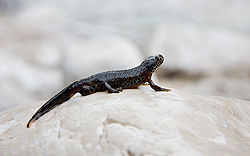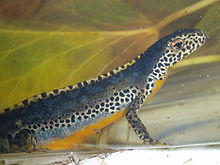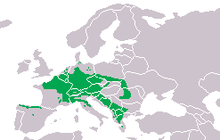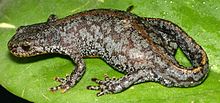- Alpine Newt
-
Alpine Newt 
Conservation status Scientific classification Kingdom: Animalia Phylum: Chordata Class: Amphibia Order: Caudata Family: Salamandridae Genus: Ichthyosaura Species: I. alpestris Binomial name Ichthyosaura alpestris
(Laurenti, 1768)Synonyms Triturus alpestris
The Alpine Newt (Ichthyosaura alpestris, formerly Triturus alpestris and Mesotriton alpestris) is a newt of the Salamander order Caudata (or Urodela) in the class of Amphibians.
Contents
Description
During the mating season early in the year, the males exhibit blue colouring on their backs; their flanks are stippled black and white, and on the belly are marked with a blue stripe. The shallow crest is alternately spotted yellow and black. The females, in water camouflage, are mottle grey-brown-green and have some weak spotting on the back. The belly side of both sexes is bright orange to vermillion and always unmarked. The biggest of the males can reach up to nine, and the females up to twelve centimeters in length. After the mating season, older specimens have a darker, almost black, velvety skin (land camouflage).Prince Newton aka EVERETT!
Life and Habitat
Alpine newts typically inhabit forests with good access to water in hilly to mountainous regions. They are mostly absent in forest-poor areas. They populate well in thick deciduous forests, as well as parkland and natural gardens. Outside the spawning season, Alpine newts live terrestrially. During the day it stays in all kinds of undergrowth, but during the mating season in cool water (forest pools, artificial pools). After the adults come out of winter dormancy, they migrate to their spawning pools.
Distribution
Alpine newts were originally confined to Central Europe and mountainous Southern Europe, as well as an isolated area on the northern Iberian Peninsula. The species was introduced to southern England in the 1930s and several populations have become established as far north as Sunderland.[2]
Taxonomy
The Alpine Newt was formerly placed within the genus Triturus. García-París et al.[3] divided the genus Triturus, placing the Alpine Newt into its own genus Mesotriton. Later Mesotriton was postulated to be a junior synonym of Ichthyosaura.[4] Ten subspecies of the Alpine Newt are recognized (some only with neotenic forms).
- I. a. alpestris (Laurenti, 1768) Alpine Newt
- I. a. apuanus (Gray, 1850) Italian Alpine Newt
- I. a. cyreni (Mertens & Muller, 1940) Spanish Alpine Newt
- I. a. inexpectatus (Dubois & Breuil, 1983) Calabrian Alpine Newt
- I. a. lacusnigri (Dely, 1960) Yugoslavian Alpine Newt
- I. a. montenegrinus (Radovanovic, 1951) Montenegran Alpine Newt
- I. a. piperianus (Radovanovic, 1961)
- I. a. reiseri (Schreiber, 1912) Bosnian Alpine Newt
- I. a. serdarus (Radovanovic, 1961)
- I. a. veluchiensis (Wolterstorff, 1935) Greek Alpine Newt
References
- ^ Arntzen, J.W. et al. (2006). Triturus alpestris. In: IUCN 2008. IUCN Red List of Threatened Species. Downloaded on 2009-02-03.
- ^ Bond, I. & Haydock, G. 2008. The Alpine Newt in northern England. Herpetological Bulletin 104: 4-6
- ^ García-París, M., A. Montori, and P. Herrero. 2004. Amphibia: Lissamphibia. Fauna Iberica Vol. 24. Madrid: Museo Nacional de Ciencias Naturales and Consejo Superior de Investigaciones Científicas.
- ^ Josef F. Schmidtler. 2007. Die Wurzeln einer bayrischen Herpetofaunistik im 18. und beginnenden 19. Jahrhundert. Zeitschrift f. Feldherpetologie 14: 93–119. Laurenti, Bielefeld. (PDF online, in German; see page 105)
External links
Categories:- IUCN Red List least concern species
- Newts
- Amphibians of Europe
Wikimedia Foundation. 2010.




